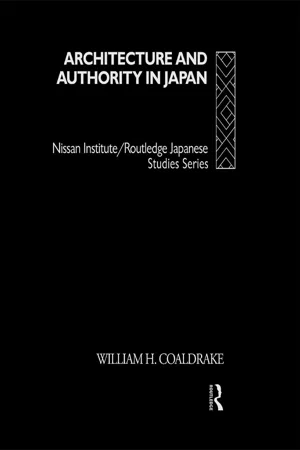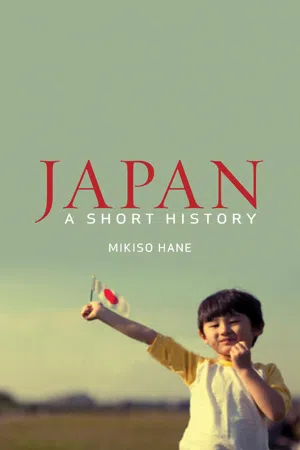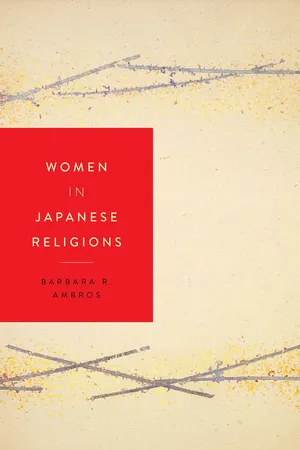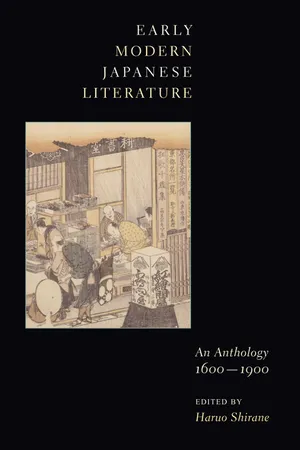History
Heian Period
The Heian Period in Japan, lasting from 794 to 1185, was characterized by a flourishing of art, literature, and culture. It was a time of peace and stability, during which the imperial court in Kyoto became the center of political and cultural life. The period is known for the development of classical Japanese literature, including the famous novel "The Tale of Genji."
Written by Perlego with AI-assistance
Related key terms
4 Key excerpts on "Heian Period"
- eBook - ePub
- William H. Coaldrake(Author)
- 2002(Publication Date)
- Routledge(Publisher)
4 Heian Palaces and Kamakura Temples The Changing Countenances of Aristocratic and Warrior Power The 700 years from the establishment of a new capital city of Heian in 794 to the outbreak of the Onin War in 1467, which destroyed much of the city, was an epoch of profound change in both authority and architecture. It covers the three historical periods of Heian (794–1185), Kamakura (1185–1333) and Muromachi (1333–1467). The general historical framework of these periods is well known and need be mentioned only briefly here. The Heian Period saw the flourishing of indigenous forms of government and culture under the civil aristocracy in the Heian capital, now generally referred to by its modern name of Kyoto. The centralised authority of aristocratic government based in Kyoto was eroded by the growth of private land holdings in the provinces, and by the creation of warrior bands to protect and promote these landed interests. Political and military turbulence reached its culmination with the defeat of the Taira forces by those of the Minamoto in 1185 and the establishment of a warrior government at Kamakura. Minamoto Yoritomo assumed the court title of shogun, setting the precedent of using this imperially conferred office to sanction de facto warrior power as de jure government. The succeeding period witnessed an uneasy balance between the civil power of the court in Kyoto and the military power of the warrior class at Kamakura. 1 By the end of the fourteenth century the balance had shifted decisively towards the military. The overthrow of the Kamakura shogunate by a coalition of disaffected warrior and aristocratic interests under the leadership of the Ashikaga family saw the destruction of the city of Kamakura, and the establishment of warrior government in Kyoto itself. The warrior class was gradually absorbed into the cultural milieu of the old capital - eBook - ePub
Japan
A Short History
- Mikiso Hane(Author)
- 2013(Publication Date)
- Oneworld Publications(Publisher)
Other reforms included systematization of tax collection, the adoption of a military conscription system (which was abandoned in 792 because of its inefficiency), and the establishment of checkpoints at strategic places to restrict the movement of people such as peasants fleeing tax collectors. Another Chinese practice that was adopted was the establishment of a permanent capital at Nara in 710. Prior to this the political center was wherever the Emperor resided. Now for the first time an elaborate capital city patterned after the Tang capital of Zhang-an was constructed. In 784 the Emperor Kammu (737–806) moved the capital to Heian-kyō (Kyoto). The era known as Heian Period commenced in 784.The policy of adopting Tang administrative and legal practices in order to strengthen the imperial court resulted in the centralization of authority under the imperial government. Emperors, however, seldom exercised authority directly; they relied on the court officials to oversee the administrative affairs. Imperial regents also emerged as powerful leaders. Initially regents served during the minority of the Emperor or during the reign of an Empress but toward the end of the ninth century the regency came to be occupied by members of the Fujiwara family, descendants of a court official who helped to institute the Taika reforms. The Fujiwara members served as regents regardless of the Emperor’s age, and came to monopolize the post. They remained as top court officials even after the imperial court lost real power with the rise of the warrior class at the end of the Heian Period. Their descendants emerged as key figures in the modern period.Fujiwara family members extended their power by intermarrying with the imperial family, and by increasing their holdings of tax-free estates. The sumptuous lifestyle of the Fujiwara clan and the emergence of the Heian court as the nerve center of Japan resulted in a flourishing of cultural and intellectual life.While the Fujiwara clan was exercising power at the center, the outlying regions were beginning to witness the rise of military chieftains who were gradually extending their control by increasing their shōen holdings. At the court Fujiwara political monopoly was beginning to be challenged by the Emperors. The first Emperor who sought to exert direct authority was Emperor Shirakawa (1053–1129) because during his reign there were no dominant Fujiwara family members. After he retired he sought to exclude the Fujiwara family from the government by acting as the guardian of his successor who was a child. This practice was continued by subsequent retired Emperors who usually entered a monastery. This political practice came to be known as “cloister government.” - eBook - ePub
- Barbara R Ambros(Author)
- 2015(Publication Date)
- NYU Press(Publisher)
4The Heian Period
Women in Buddhism and Court Ritual
From the sixth through the eighth centuries, Buddhism was marked by a relative inclusiveness toward women. This was to change in the Heian Period (794–1185). The imperial court moved the capital first in 784 to Nagaoka and then in 794 to Heiankyō, after which the new period has been named. Heiankyō, now known as Kyoto, remained the imperial capital until 1868. It is from the Heian Period onward that we gradually have more information about individual women’s lives and religious practices, particularly among the aristocracy. Despite the inequities of polygyny, the prevailing marriage system allowed elite women to remain integrated into their natal families, and they could inherit property freely. Women could also hold some kinds of government offices: they could serve as palace attendants or, to a limited extent, as priestesses at state-sponsored shrines as the power of female shamans waned. Furthermore, even though the system of state-sponsored Buddhist convents declined with the result that nuns no longer officiated in state rituals, elite women engaged in devotional practices as nuns, pilgrims, and patrons.Marriage and Inheritance
Heian marriage and inheritance patterns shaped women’s religious choices and opportunities. In premodern Japan, polygyny was an accepted practice among social elites. The Yōrō Code of the early eighth century technically allowed a man to have one principal wife while having as many concubines as he pleased. This practice was based on Chinese models. Heian-period evidence suggests that the Japanese made no rigid distinctions between wives and concubines. There was a sense, however, that the principal wife had a privileged status compared to the secondary wives: she had special titles unique to her position, the husband was more likely to reside with her, and her sons would receive higher official appointments. The position of principal wife often fell to the woman whom a man married first, but in certain cases the principal wife was determined upon the selection of the wife’s son as the principal heir. If the relationship with the principal wife ended in divorce or death, another wife might take her place. While the number of secondary wives was not legally restricted, in practice the number of wives in simultaneous relationships with a husband was usually limited to two or three, if not one. In addition to marriage, aristocrats would also engage in casual relationships with women serving as ladies-in-waiting at the imperial court, or they could take temporary wives while on an official appointment in the provinces.1 - eBook - ePub
Early Modern Japanese Literature
An Anthology, 1600-1900
- Haruo Shirane(Author)
- 2002(Publication Date)
- Columbia University Press(Publisher)
Chapter 1EARLY MODERN JAPANOne of the most dramatic transformations in Japanese history was the transition from the medieval period (thirteenth to sixteenth century) to the early modern era (1600–1867), when literary and cultural paradigms gave birth to a whole new body of vernacular literature. During the seventeenth century, urban commoners (chō nin) emerged as an economically and culturally powerful class; mass education spread, especially through the domain (han) schools for samurai and the private schools (terakoya) for commoners; and printing was introduced—all of which led to the widespread production and consumption of popular literature, which became a commodity for huge markets. As a result, traditional Japanese and Chinese literary texts were widely read for the first time.1Until the seventeenth century, literary texts had been shared through limited quantities of handwritten manuscripts, almost all of which belonged to a small group of aristocrats, priests, and high-ranking samurai. In the medieval period, traveling minstrels (biwa hō shi) had recited military epics such as The Tale of the Heike to a populace that could neither read nor write. Even most samurai were illiterate, as were farmers and craftsmen. But in the seventeenth century, with the creation of a new socioeconomic structure, the government promotion of education, and the spread of print capitalism, this situation changed drastically. By midcentury, almost all samurai—now the bureaucratic elite—were able to read, as were the middle to upper levels of the farmer, artisan, and merchant classes.The seventeenth century brought not only a dramatic rise in the standard of living for almost all levels of society but also a dramatic change in the nature of cultural production and consumption. In the medieval period, although provincial military lords were able to learn about the Heian classics from such traveling renga (classical linked verse) masters as Sō gi (1421–1502), the acquisition of these classical texts was limited to a relatively small circle of poet-priests and aristocrats, who were deeply rooted in the traditional culture of Kyoto. A monopoly—epitomized by the Kokin denju, the secret transmission of the Kokinshū (Anthology of Old and New Japanese Poems, ca. 905)—was established over a significant part of so-called refined culture, which was often passed on through carefully controlled lineages in one-to-one transmissions to the elected few. In the seventeenth century, by contrast, anyone who could afford to pay for lessons could hire a “town teacher” (machi shishō ) in any one of the many arts or fields of learning. The transmission of learning was no longer dependent, as it had been in the medieval period, on the authority or patronage of large institutions such as Buddhist temples or powerful military lords. Such cultural activities as writing haikai poetry, singing nō (utai), and performing the tea ceremony (chanoyu
Index pages curate the most relevant extracts from our library of academic textbooks. They’ve been created using an in-house natural language model (NLM), each adding context and meaning to key research topics.



